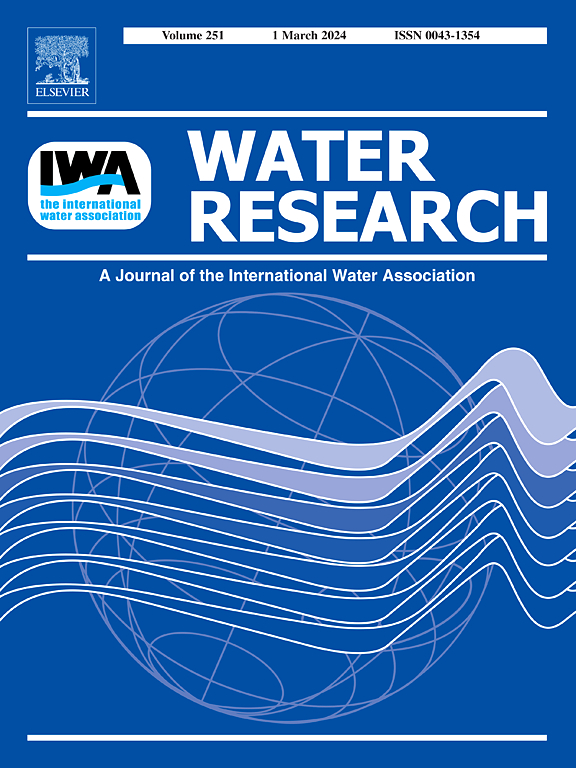Characteristics of aqueous film forming foam (AFFF) sites impacted with per- and polyfluoroalkyl substances (PFAS): A 37-site study
IF 12.4
1区 环境科学与生态学
Q1 ENGINEERING, ENVIRONMENTAL
引用次数: 0
Abstract
A meta-analysis of 37 military aqueous film-forming foam (AFFF) sites was conducted to gain insights into the fate and transport of seven key perfluoroalkyl acids (PFAAs): PFOS, PFOA, PFHxS, PFHxA, PFBS, PFBA, and PFNA. Specifically, this study aims to examine occurrence of the seven PFAAs in soil and groundwater at AFFF source zones and understand PFAA plume characteristics as well as estimate plume lengths. Based on an evaluation of these PFAAs in soil samples collected in the source zone, the highest concentrations predominantly occur within the top one meter (m) below ground surface (bgs). PFOS and PFOA are the major PFAA contributors in soil at source zones, whereas groundwater exhibits a more diverse concentration distribution. Inferred Current Plume Lengths are presented for the seven PFAAs, with median plume lengths ranging from 220 to 800 m. Finally, an exceedance magnitude assessment was conducted to evaluate the potential contribution of each studied PFAA to the exceedance of groundwater regional screening levels (RSLs) or maximum contaminant levels (MCLs). Results indicate that at typical AFFF sites, PFOS, PFOA, and PFHxS generally contribute 99 % of the estimated exceedance magnitude, whereas short-chained PFAAs (PFHxA, PFBS, and PFBA) contribute <1 %.
受全氟烷基和多氟烷基物质(PFAS)影响的水成膜泡沫(AFFF)部位的特征:一项37个部位的研究
对37个军用水成膜泡沫(AFFF)位点进行了荟萃分析,以深入了解七种关键的全氟烷基酸(PFAAs): PFOS、PFOA、PFHxS、PFHxA、PFBS、PFBA和PFNA的命运和运输。具体而言,本研究旨在研究7种PFAA在AFFF源区土壤和地下水中的发生情况,了解PFAA羽流特征并估计羽流长度。根据对在源区收集的土壤样品中的这些PFAAs的评估,最高浓度主要发生在地表以下1米(bgs)的顶部。源区土壤中PFAA的主要贡献者是PFOS和PFOA,而地下水中PFAA的浓度分布则更为多样化。给出了7个PFAAs的推断流羽长度,中位羽长度在220 ~ 800 m之间。最后,进行了超标幅度评估,以评估所研究的每个PFAAs对地下水区域筛选水平(RSLs)或最大污染物水平(MCLs)超标的潜在贡献。结果表明,在典型的AFFF位点,PFOS、PFOA和PFHxS通常占估计超标幅度的99%,而短链PFAAs (PFHxA、PFBS和PFBA)的贡献小于1%。
本文章由计算机程序翻译,如有差异,请以英文原文为准。
求助全文
约1分钟内获得全文
求助全文
来源期刊

Water Research
环境科学-工程:环境
CiteScore
20.80
自引率
9.40%
发文量
1307
审稿时长
38 days
期刊介绍:
Water Research, along with its open access companion journal Water Research X, serves as a platform for publishing original research papers covering various aspects of the science and technology related to the anthropogenic water cycle, water quality, and its management worldwide. The audience targeted by the journal comprises biologists, chemical engineers, chemists, civil engineers, environmental engineers, limnologists, and microbiologists. The scope of the journal include:
•Treatment processes for water and wastewaters (municipal, agricultural, industrial, and on-site treatment), including resource recovery and residuals management;
•Urban hydrology including sewer systems, stormwater management, and green infrastructure;
•Drinking water treatment and distribution;
•Potable and non-potable water reuse;
•Sanitation, public health, and risk assessment;
•Anaerobic digestion, solid and hazardous waste management, including source characterization and the effects and control of leachates and gaseous emissions;
•Contaminants (chemical, microbial, anthropogenic particles such as nanoparticles or microplastics) and related water quality sensing, monitoring, fate, and assessment;
•Anthropogenic impacts on inland, tidal, coastal and urban waters, focusing on surface and ground waters, and point and non-point sources of pollution;
•Environmental restoration, linked to surface water, groundwater and groundwater remediation;
•Analysis of the interfaces between sediments and water, and between water and atmosphere, focusing specifically on anthropogenic impacts;
•Mathematical modelling, systems analysis, machine learning, and beneficial use of big data related to the anthropogenic water cycle;
•Socio-economic, policy, and regulations studies.
 求助内容:
求助内容: 应助结果提醒方式:
应助结果提醒方式:


